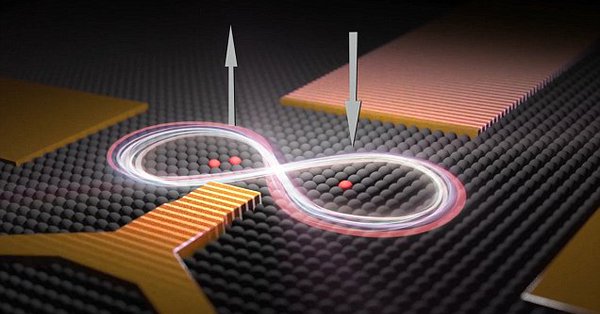The study, which was led by researchers from the University of New South Wales, involved creating qubits by precisely positioning individual phosphorus atoms in a silicon chip.
Quantum bits, or qubits, are a unit of measure for quantum information.
Once positioned, the scientists were able to get the qubits to communicate and correlate with each other.
Pictured is an artist's impression of two 'qubits' or quantum bits. Scientists at the University of New South Wales were able to control the interaction of these qubits to make them 'talk'
The move is being heralded as a 'significant milestone' in the broader effort to build a world-beating quantum computer.
Building a quantum computer has been called the 'space race of the 21st century' – a difficult and ambitious challenge, with the potential to deliver revolutionary tools.
The team of researchers, which is led by Australian of the year Michelle Simmons, is the only group in the world that can see the exact position of their qubits, according to a release from the University of New South Wales.
'Our competitive advantage is that we can put our high-quality qubit where we want it in the chip, see what we've made, and then measure how it behaves,' Simmons explained.
The scientists were able to control the interactions between the neighboring qubits, so that they became correlated, or communicated with one another.
They did this by placing two qubits 16 nanometers apart in a silicon chip.
Using electrodes patterned onto the chip, they were able to control the interactions between the neighboring qubits, so that the 'quantum spins' of their electrons became correlated, said Dr Matthew Broome, a co-author of the study.
'It was fascinating to watch,' Broome explained. 'When the spin of one electron is pointing up, the other points down, and vice versa.'
'These type of spin correlations are the precursor to the entangled states that are necessary for a quantum computer to function and carry out complex calculations,' he added.
By enabling the qubits to communicate with each other, the scientists are now one step closer to achieving entanglement, which is essential to building a quantum computer, the Australian Financial Review noted.
In the past, theories had predicted that two qubits would have to be placed 20 nanometers apart in order to correlate, Sam Gorman, another co-author of the study, noted.
Instead, the scientists only had to place the phosphorous atoms 16 nanometers apart.
'In our quantum world, this is a very big difference,' Gorman explained.
'It is also brilliant, as an experimentalist, to be challenging this theory,' he added.
Unlike traditional computers, which are bound to two different states, quantum computers are able to exist in multiple states at once.
This allows quantum computers to process information at more than twice the speed and in a far more efficient manner.
Seemingly every Silicon Valley giant has put down a stake in the race to create the first quantum computer, including Microsoft, Intel, Google and many others.
WHAT IS A QUANTUM COMPUTER AND HOW DOES IT WORK?
The key to a quantum computer is its ability to operate on the basis of a circuit not only being 'on' or 'off', but occupying a state that is both 'on' and 'off' at the same time.
While this may seem strange, it's down to the laws of quantum mechanics, which govern the behaviour of the particles which make up an atom.
At this micro scale, matter acts in ways that would be impossible at the macro scale of the universe we live in.
Quantum mechanics allows these extremely small particles to exist in multiple states, known as 'superposition', until they are either seen or interfered with.
A good analogy is that of a coin spinning in the air. It cannot be said to be either a 'heads' or 'tails' until it lands.
The heart of modern computing is binary code, which has served computers for decades.
While a classical computer has 'bits' made up of zeros and ones, a quantum computer has 'qubits' which can take on the value of zero or one, or even both simultaneously.
One of the major stumbling blocks for the development of quantum computers has been demonstrating they can beat classical computers.
Google, IBM, and Intel are among companies competing to achieve this.
More about: science
















































